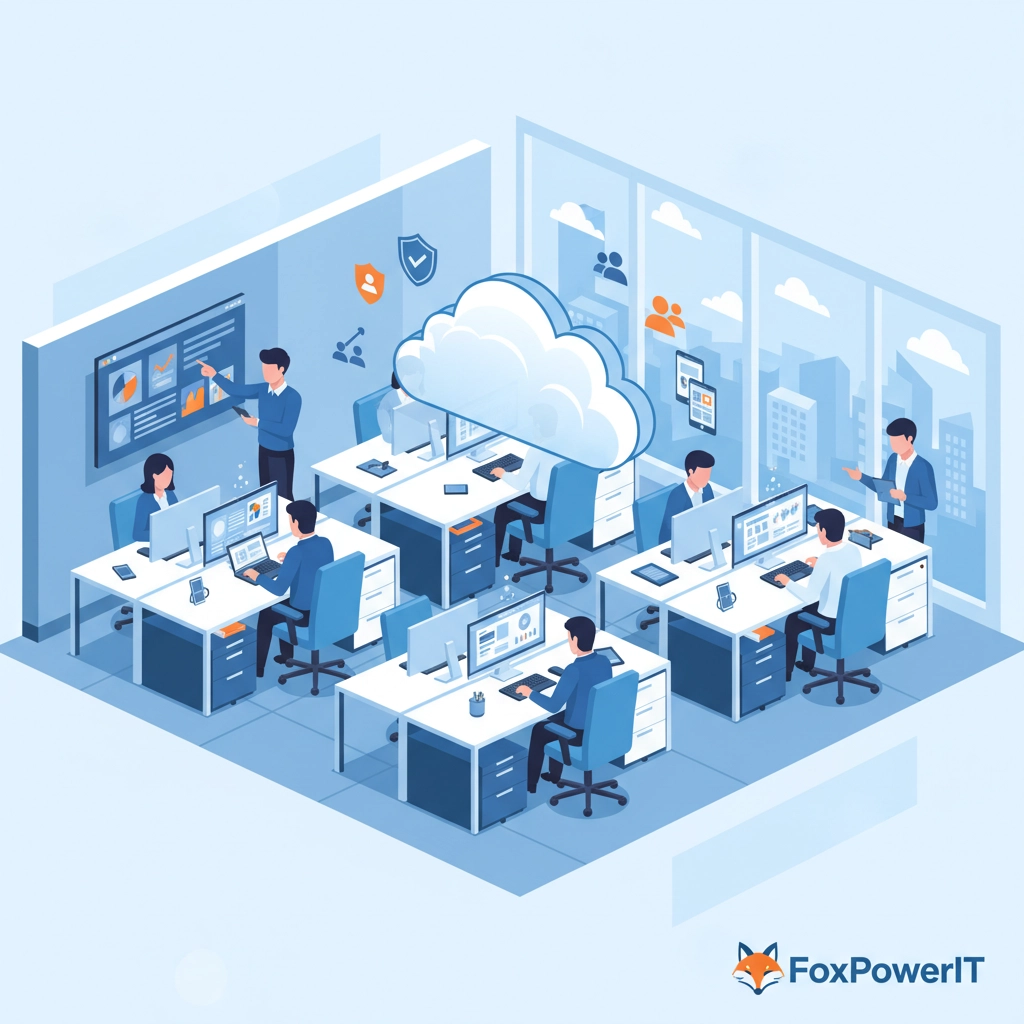When Sarah Martinez, managing partner at a mid-sized Connecticut accounting firm, first heard about cloud migration in 2019, her immediate response was, "Why fix something that isn't broken?" Her on-premise servers had served the firm faithfully for over a decade. Client files were secure, backups ran nightly, and her team knew exactly where everything lived.
Fast-forward to March 2020, and Sarah found herself frantically trying to set up remote access for 15 accountants who suddenly needed to work from home. What should have been a simple transition turned into weeks of VPN headaches, security concerns, and frustrated clients waiting for delayed tax returns. That's when Sarah realized her "perfectly functional" system had become a liability overnight.
By 2021, Sarah's firm had completed a full cloud migration with the help of FoxPowerIT. Today, she can't imagine running her practice any other way. "The cloud didn't just solve our remote work problems," she explains. "It transformed how we serve clients and manage our business."
Sarah's story isn't unique. Across Connecticut, accounting firms have been making the leap to cloud-based systems, and their experiences offer valuable lessons for practices still on the fence about migration. Let's explore what these firms learned, what worked, what didn't, and how you can apply these insights to your own cloud journey.
Why Connecticut Accounting Firms Are Moving to the Cloud
The push toward cloud adoption among Connecticut accounting firms accelerated dramatically after 2020, but the underlying drivers extend far beyond pandemic-induced remote work needs. Modern accounting practices face mounting pressure from several directions: clients expect real-time access to their financial data, regulatory compliance requirements continue to expand, and competition from cloud-native firms is intensifying.

Traditional on-premise systems, while reliable, create bottlenecks that cloud-based solutions eliminate. When client data lives in the cloud, accountants can access it from anywhere, collaborate in real-time, and provide faster turnarounds on critical financial reports. More importantly, cloud platforms offer automatic updates, built-in security protocols, and scalability that grows with the business.
The financial benefits also prove compelling. While on-premise systems require significant upfront capital investments in hardware, licensing, and IT infrastructure, cloud solutions operate on a predictable subscription model. This shift from capital expenditure to operational expenditure helps accounting firms better manage cash flow and allocate resources more efficiently.
Security concerns, once the primary barrier to cloud adoption, have largely been resolved through advances in encryption, multi-factor authentication, and compliance certifications. Major cloud providers now offer security standards that exceed what most small and medium-sized accounting firms could implement in-house.
The Migration Journey: A Step-by-Step Analysis
Based on interviews with Connecticut accounting firms that have successfully migrated to the cloud, a clear roadmap emerges. The most successful migrations follow a structured approach that prioritizes planning, minimizes disruption, and ensures team buy-in throughout the process.
Phase 1: Assessment and Planning (Months 1-2)
The assessment phase proves critical for establishing realistic expectations and budgets. Firms that rushed through this stage often encountered unexpected complications later in the process. Successful migrations begin with a comprehensive audit of existing systems, workflows, and data structures.
Michael Chen, partner at a Stamford-based accounting firm, learned this lesson the hard way. "We thought we could just move everything to the cloud in a weekend," he recalls. "We ended up with three weeks of downtime because we hadn't properly mapped our data dependencies."
The assessment should include:
- Complete inventory of current software applications and their cloud compatibility
- Analysis of data storage requirements and bandwidth needs
- Evaluation of existing security protocols and compliance requirements
- Documentation of critical workflows and system interdependencies
- Staff skill assessment and training needs identification
Phase 2: Platform Selection and Architecture Design (Months 2-3)
Platform selection represents one of the most consequential decisions in the migration process. Connecticut firms have gravitated toward different solutions based on their specific needs, client base, and technical requirements.
Microsoft 365 has emerged as a popular choice for firms seeking integrated productivity tools alongside cloud storage. The platform's familiarity factor helps reduce training time, and its robust security features address compliance concerns common in the accounting industry.
QuickBooks Online and other cloud-native accounting platforms offer specialized functionality that generic cloud storage solutions lack. However, firms with complex reporting requirements or extensive customizations may find these platforms limiting.
Some practices opt for hybrid approaches, maintaining certain applications on-premise while moving others to the cloud. This strategy can provide flexibility but increases complexity and ongoing management requirements.
Phase 3: Data Migration and Testing (Months 3-4)
The data migration phase represents the highest-risk period in the cloud adoption process. Successful firms approach this stage with extreme caution, implementing multiple backup systems and conducting extensive testing before going live.
Jennifer Walsh, managing partner at a New Haven accounting firm, emphasizes the importance of pilot testing. "We migrated one client's data first and ran parallel systems for a full month," she explains. "This allowed us to identify and resolve issues without impacting our entire client base."
Best practices for data migration include:
- Creating multiple backups before beginning the migration process
- Testing migration procedures with non-critical data first
- Establishing data integrity verification protocols
- Implementing rollback procedures in case of migration failures
- Scheduling migrations during low-usage periods to minimize disruption
Phase 4: Team Training and Adoption (Months 4-5)
Technology adoption ultimately succeeds or fails based on user acceptance. Accounting firms report that comprehensive training programs significantly improve migration outcomes and reduce long-term support requirements.
Effective training programs address both technical skills and workflow changes. Staff members need to understand not just how to use new systems, but how these systems change their daily responsibilities and client interactions.
Robert Johnson, a senior accountant at a Waterbury firm, noted that training should be ongoing rather than one-time events. "The software keeps evolving, and we keep discovering new features that can improve our efficiency. Having regular training sessions helps everyone stay current."
Real-World Benefits: What Connecticut Firms Are Experiencing

The benefits of cloud migration extend far beyond the obvious advantages of remote access and automatic backups. Connecticut accounting firms report improvements in areas they hadn't anticipated when planning their migrations.
Enhanced Client Service and Collaboration
Cloud-based systems have fundamentally changed how accounting firms interact with their clients. Real-time access to financial data enables faster response times and more proactive advisory services.
Lisa Park, CPA at a Fairfield County firm, describes the transformation: "Before the cloud, preparing for client meetings meant printing stacks of reports and hoping we had the most current data. Now, we can pull up real-time financial information during the meeting and make immediate adjustments to forecasts or budgets."
Client portals integrated with cloud platforms allow secure document sharing and eliminate the back-and-forth of email attachments. Clients can access their financial reports, tax documents, and other critical information 24/7, improving satisfaction and reducing administrative burden on firm staff.
Improved Disaster Recovery and Business Continuity
Traditional backup systems, while necessary, often prove inadequate during actual disasters. Cloud-based systems provide automatic, redundant backups across multiple geographic locations, ensuring business continuity even during major disruptions.
The COVID-19 pandemic provided an unexpected test of disaster recovery capabilities. Firms with cloud-based systems transitioned to remote work within days, while those relying on on-premise systems struggled for weeks to establish reliable remote access.
Beyond pandemic responses, cloud systems protect against hardware failures, cyber attacks, and natural disasters. Automatic backups eliminate the risk of human error in backup procedures, and geographic redundancy ensures data survival even during regional disasters.
Cost Optimization and Predictable Budgeting
While initial cloud migration costs can be substantial, most Connecticut accounting firms report long-term cost savings through reduced hardware expenses, elimination of server maintenance costs, and improved operational efficiency.
The subscription-based pricing model of cloud services provides predictable monthly expenses that simplify budgeting and cash flow management. This predictability particularly benefits smaller firms that previously faced large, unpredictable expenses when servers failed or required upgrades.
Energy costs also decrease significantly when on-premise servers are eliminated. Server rooms require consistent cooling and power, representing hidden costs that cloud migration eliminates.
Scalability and Flexibility
Traditional IT infrastructure requires firms to anticipate future needs and invest accordingly. This often results in either over-provisioning (wasting resources) or under-provisioning (limiting growth). Cloud platforms allow firms to scale resources up or down based on actual demand.
During tax season, accounting firms can temporarily increase computing resources to handle peak workloads, then scale back during slower periods. This flexibility optimizes costs and ensures adequate performance when it matters most.
Common Challenges and How Successful Firms Overcame Them
Despite the clear benefits of cloud migration, the process presents significant challenges that can derail unprepared organizations. Connecticut accounting firms that successfully completed migrations learned to anticipate and address these obstacles proactively.
Internet Dependency and Connectivity Issues
Cloud systems require reliable internet connectivity to function effectively. Firms in rural Connecticut areas sometimes struggle with bandwidth limitations or service reliability issues that urban practices don't face.
Successful firms address connectivity concerns by implementing redundant internet connections from different providers. This ensures business continuity even if the primary connection fails. Some firms also maintain limited offline capabilities for critical functions during internet outages.
Staff Resistance and Change Management
Technology changes often meet resistance from staff members comfortable with existing systems. This resistance can undermine migration success if not properly addressed through change management strategies.
Firms report success by involving staff members in the migration planning process, providing comprehensive training programs, and clearly communicating the benefits of new systems. Appointing "change champions" from within existing staff helps build internal support for the migration.
Data Security and Compliance Concerns
Despite improvements in cloud security, accounting firms must carefully evaluate compliance requirements and security protocols. Client confidentiality and regulatory compliance represent non-negotiable requirements that cloud systems must satisfy.
Successful migrations include thorough security assessments, implementation of multi-factor authentication, and regular security audits. Firms also establish clear data governance policies that define who can access what information and under what circumstances.
Integration Complexities
Accounting firms often use specialized software applications that may not integrate seamlessly with cloud platforms. These integration challenges can create workflow disruptions if not properly addressed during migration planning.
Successful firms conduct comprehensive application audits before migration, identifying integration requirements and potential compatibility issues. Some applications may require replacement with cloud-native alternatives, while others may need custom integration development.
The Role of Professional IT Support in Successful Migrations
Connecticut accounting firms consistently emphasize the importance of working with experienced IT professionals during cloud migrations. The complexity of modern accounting technology stacks requires expertise that most firms don't possess in-house.

FoxPowerIT has guided numerous Connecticut accounting firms through successful cloud migrations by providing comprehensive support throughout the entire process. This support includes initial assessment and planning, platform selection guidance, data migration execution, staff training, and ongoing system management.
Professional IT support proves particularly valuable in addressing the technical complexities of cloud migrations while allowing accounting professionals to focus on serving clients. Attempting to manage migrations in-house often results in extended timelines, cost overruns, and suboptimal outcomes.
The ongoing nature of cloud management also benefits from professional support. Cloud platforms evolve rapidly, with new features, security updates, and optimization opportunities requiring continuous attention. Partnering with experienced IT professionals ensures that accounting firms can maximize the value of their cloud investments.
Microsoft 365 Migration: The Popular Choice for Connecticut Firms
Microsoft 365 has emerged as the platform of choice for many Connecticut accounting firms due to its comprehensive feature set, robust security capabilities, and familiar user interface. The platform combines productivity applications, cloud storage, and communication tools in a single, integrated environment.
The migration to Microsoft 365 typically involves transitioning email systems, document storage, and collaboration tools simultaneously. This comprehensive approach minimizes the number of separate migration projects and ensures better integration between different business functions.
Security features built into Microsoft 365 address many compliance concerns specific to accounting firms. Advanced threat protection, data loss prevention, and audit logging capabilities help firms meet regulatory requirements while protecting sensitive client information.
However, Microsoft 365 migration also presents unique challenges. Email migration can be particularly complex, especially for firms with large historical email archives. Document migration requires careful attention to folder structures and permission settings to ensure that access controls remain appropriate after migration.
Successful Microsoft 365 migrations typically involve phased approaches that prioritize critical functions first, then gradually migrate less essential applications and data. This strategy minimizes disruption while ensuring that business operations can continue throughout the migration process.
Cloud Migration Costs: Budgeting for Success
Understanding the full cost structure of cloud migration helps accounting firms budget appropriately and avoid unexpected expenses. While subscription costs are predictable, migration costs can vary significantly based on complexity, timeline, and support requirements.
Initial migration costs typically include professional services for planning and execution, staff training, and potential application licensing changes. Data migration tools and temporary parallel system operation also contribute to upfront expenses.
However, most Connecticut firms report that cloud migration delivers positive return on investment within 12-24 months through reduced hardware costs, lower maintenance expenses, and improved operational efficiency. The key is realistic budgeting that accounts for both expected and unexpected costs throughout the migration process.
Ongoing costs include cloud platform subscriptions, internet connectivity upgrades, and continued professional support. These costs are generally predictable and often lower than equivalent on-premise expenses when all factors are considered.
Future-Proofing Your Practice: Beyond Basic Cloud Migration

Successful cloud migration provides the foundation for ongoing technological advancement and business improvement. Connecticut accounting firms that view migration as a one-time project miss opportunities for continuous optimization and competitive advantage.
Advanced cloud capabilities like artificial intelligence, machine learning, and advanced analytics become accessible once basic migration is complete. These technologies can automate routine tasks, identify patterns in financial data, and provide insights that improve client advisory services.
Integration with emerging technologies also becomes simpler in cloud environments. As new accounting applications and services are developed, cloud-based firms can more easily evaluate and adopt innovations that improve their competitive position.
The data visibility provided by cloud systems also enables better business intelligence and practice management. Firms can analyze their own operational data to identify efficiency opportunities, client service improvements, and growth strategies.
Getting Started: Your Cloud Migration Action Plan
If your Connecticut accounting firm is considering cloud migration, the experiences of your peers suggest a deliberate, well-planned approach yields the best results. Start by conducting a comprehensive assessment of your current systems, identifying specific business objectives you hope to achieve through migration.
Engage professional IT support early in the planning process. The complexity of modern accounting technology environments requires expertise that extends beyond basic computer skills. Professional guidance can help you avoid common pitfalls and achieve better outcomes.
Consider starting with a pilot migration involving a subset of your data or applications. This approach allows you to test procedures, identify challenges, and refine your approach before committing to full migration.
Plan for comprehensive staff training and change management. Technology adoption succeeds only when users embrace new systems and understand how to leverage their capabilities effectively.
Finally, view cloud migration as an ongoing journey rather than a destination. The cloud computing landscape continues to evolve rapidly, and firms that actively pursue optimization and improvement will realize greater long-term benefits.
The Connecticut accounting firms that have successfully made the jump to cloud-based systems consistently report that the benefits exceeded their expectations. While migration presents challenges, proper planning, professional support, and realistic expectations lead to positive outcomes that transform how practices operate and serve clients.
Whether you're motivated by remote work requirements, client service improvements, or competitive positioning, cloud migration offers compelling advantages for modern accounting practices. The key is learning from the experiences of firms that have already made the journey successfully and applying their lessons to your own migration planning.
For Connecticut accounting firms ready to explore cloud migration opportunities, FoxPowerIT offers comprehensive migration planning and support services designed specifically for the unique needs of accounting professionals. Our experience with local firms provides insights that ensure successful migrations while minimizing disruption to your practice and client service capabilities.
The cloud migration roadmap may seem daunting, but with proper planning, professional support, and commitment to change management, your accounting firm can join the growing number of Connecticut practices that have discovered the transformative power of cloud-based systems.

